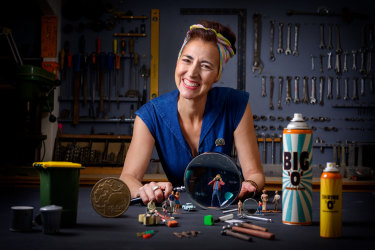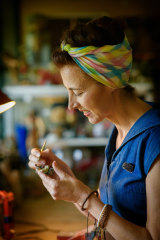Why the ABC fell in love with one woman’s tiny world
By Penelope Debelle
Little things are big right now. For 30 years, Adelaide cinematographer JoAnne Bouzianis-Sellick, presenter of ABC TV’s Tiny Oz, has been behind the scenes as a miniaturist for stop-motion animation in short films and ads.
Think Louie the Fly, the grubby little Barbie- sized star of Mortein’s television ads who flew straight from rubbish tips to you. “I made his little purple filthy waistcoat, all fly stained and ratty,” she says with fond pride.

JoAnne Bouzianis-Sellick’s work is influenced by learning to make things at home as a kid.Credit:Ben Searcy
Working with Adelaide animation company Anifex as a camera assistant, she would light the sets for short films and commercials and in her downtime make miniature wardrobes for the characters, including, on one occasion, a tiny tutu for a Pascall lolly.
“I’m basically paid to go to kindergarten really,” says Bouzianis-Sellick. “Every day is different. If we needed to do something we had to build it. If we needed to shoot at a beach, we had to build a beach.”
So when production company Northern Pictures approached her in 2019 to be a mentor on a program about tiny things, she was the perfect fit. They wanted to make a show that had something to do with scale, and she was given a budget to make a proof-of-concept pilot that also served as a screen test. For those who haven’t yet tuned in to Tiny Oz, Bouzianis-Sellick’s on-screen warmth and art-school vibe – Jackie O glasses, a wattle dress, headscarves and a Kombi van – is part of the show’s colourful appeal. “They gave me a budget for a cinematographer and I just wrote what I thought people would be interested in,” she says. “Capturing events in time was their concept, but I gave them a showing of what miniatures are about, how to deal with different scales and lots of demographics.”
Unsurprisingly, the ABC loved her, and the three-episode program was commissioned with the idea of focusing on discrete moments in history: a miniature recreation of Broome during its heyday as the world’s pearling capital; the 1916 relocation of hundreds of exotic animals through Sydney to their new home at Taronga Park Zoo; and the momentous launch of Australia’s first hot-air balloon above the Botanic Gardens of Adelaide.
The program’s inclusive twist is to use these recreations to tap into and celebrate the unsung community of miniaturists around Australia who quietly make guerilla dioramas in public spaces, construct model railways in their ever-expanding sheds and lean-tos, or craft kitchens for doll’s houses, equipped with tiny ovens and cakes. Bouzianis-Sellick is our on-air guide who explains the history and introduces us to the people making it.
The miniaturists are, let’s face it, highly motivated obsessives who are self-taught and by necessity creative. If something doesn’t exist, they have to make it. In 2005, Bouzianis-Sellick (call me Bouzis, she says on her Instagram) worked on an animated Anifex short film, Gargoyle, about a grieving young woman in a ghostly graveyard late at night who attracts the interest of one of the stone guardians of the church. The entire set for the gothic tale was made from tissues and PVA glue, and it won an AFI award for best animation.

Ingenuity is everything, says Bouzianis-Sellick.Credit:Ben Searcy
“Tissues and Aquadhere,” says Bouzianis-Sellick, laughing. “Paper towels had a bit more rigidity but they didn’t have the same suppleness.”
Ingenuity is everything. When she needed hedges and fields for an English countryside, she went to a Greek supermarket and bought bags of dried oregano and stripped the dried leaves from the stalks. (It made the room smell like pizza.) She then coated sponge foam in glue and rolled it in the crumbled oregano to make a meadow which she dotted with tiny flecks of blue and pink foam to look like wildflowers. The stalks became trees.
For the spooky forest in Gargoyle, she pulled up dried marshmallow weeds near her home and spray-painted them white on the back so they appeared moodily lit. The castle was conjured up from a Gladwrap tube, lace doilies, more tissues and plaster. “Most of our films are done on the principle ‘if you can’t make it, you can’t have it’ because most of them we don’t have a budget for,” she says. “You learn to think outside of the box.”
The miniaturists went to work, using all the ingenuity Bouzianis-Sellick knew they had. The Taronga Park episode was the easiest to walk into, because the diorama was ancillary to the Museum of Sydney’s How to Move a Zoo project. The project celebrated the successful 1916 relocation, partly by ferry or barge, of 228 mammals, 552 birds and 64 reptiles from Sydney’s first cramped and dismal zoo at Moore Park to a vastly more humane open-air bush setting at Taronga Park.
This one fascinated Bouzianis-Sellick because the model makers used the new miracle tools for miniaturists: 3D printing and precision laser cutting. “It’s a new world, a dream come true,” she says. “How many times would we say, ‘why isn’t there a box where you can just go “bzzz” and make a pair of tiny kitchen tongs?’ And now you can.”
The rueful phrase “it was a hobby gone wrong” comes up among the model makers whose work drives this show. For some, their favourite thing is to make exquisite little flowers, or throw tiny pots on a wheel, or create trees from wire and chopped foam. To experiment with elephant skin texture, talcum powder was mixed with grey paint. For the circus tents at Adelaide’s Botanic Gardens, teabags were just the thing.
“Teabags are great – they don’t fall apart in water but they become soft and malleable to let the tea through, so you can fill them with glue and manipulate them to get texture,” Bouzianis-Sellick explains. “The guys on the railways use them for tarping over train loads because as they dry, they pull tight, giving tension.”
To make a forest, all you do is strip the wire out of an electrical cable, spin it together by hand, artistically arrange its top into branches and add a leaf canopy made from chopped foam spray-painted a fetching shade of green. Then repeat that a hundred times. “When you start doing forests of trees, you never look at trees the same way as you drive into work because you’re thinking, ‘that’s an interesting shape’,” she says. “You give it a pull and a tug and you can create a whole new tree.”
The episode set in Broome was special because it was more hand-crafted, with jetties and buildings made from found objects. Most of it was the work of local miniaturist Lachie Fraser, who loves the old town and sees great beauty in its structures. He also engineered possibly the most inventive and gorgeous miniature on the show; a tiny diver’s helmet made from a repurposed washer bent down so it curved, with a ball bearing soldered on top and tiny rubber O-rings used to create the port. Spray-painted brassy gold, it was a mini masterpiece.
The Broome visit also brought Bouzianis-Sellick into contact with people tied to its history, including a diver who almost drowned when someone mistakenly turned off his air. Each day when he went diving for the pearls, he would wonder if he would see his family again. “It was an amazing story, to stand with him and listen to him. It makes me feel teary now,” she says. “He had such a lovely smile and personality and you think, ‘this could have been lost through the carelessness of someone who thought he was up and turned off the pump.’”
TAKE 7: THE ANSWERS ACCORDING TO JOANNE Bouzianis-Sellick
- Worst habit? Cannot drive by an op shop, garage sale or hard waste, or resist that vintage outfit.
- Greatest fear? Running out of time before I get all the fantastic ideas in my head made.
- The line that stayed with you? Better to be looking at it, than for it.
- Biggest regret? Shaving my sisters and my eyebrows off ... I was only six.
- Favourite room? A room that is filled with family, friends and much laughter.
- The artwork/song you wish was yours? Rundle Mall’s famous Mall’s Balls Sculpture but as a miniature, of course.
- If you could solve one thing? Poverty. The world misses out on too many amazing individuals who do not get the chance to share their skills and talents because they are struggling just to survive.
Bouzianis-Sellick, whose father is Greek and her mother English, grew up with the idea of becoming a chef and running a little Adelaide cafe. But she was heavily influenced by learning to make things at home, and remembers her father pointing out tiny insects and grubs in their garden; a slater on a leaf, or a tiny spider. Once she had a camera, her interest in visual arts took off and she majored in film photography and animation at the University of Adelaide, which led to an internship at Anifex and not long after, a job.
Her colleague Greg Sweeney, in whose workshop we met, has nothing but admiration for the way she wields his electric saw. She keeps on hand in his studio a just-in-case box of oddments, which currently include a tiny golden clock, a stationery pack with mini paper clips and stapler, a little hymn book and a crocheted starfish. “Some people say you are an artist; I see myself more as a crafter,” Bouzianis-Sellick says. “I feel that I see things and turn them into other things. I like repurposing and recycling and I make jewellery and things out of old toys and clocks, found objects.”
Her screen presence is so warm and easy it is not hard to imagine her being invited back, and to be clear, she wouldn’t mind. “I’ve had the best time ever. It’s been really fun and I really appreciate having the chance to come and play, so to speak,” she says. “I really hope there is something else out there for me – or this might just be a tiny moment in my life.”
The final episode of Tiny Oz is on ABC, Tuesday at 8.30pm, and all episodes are available on ABC iview.
Find out the next TV, streaming series and movies to add to your must-sees. Get The Watchlist delivered every Thursday.